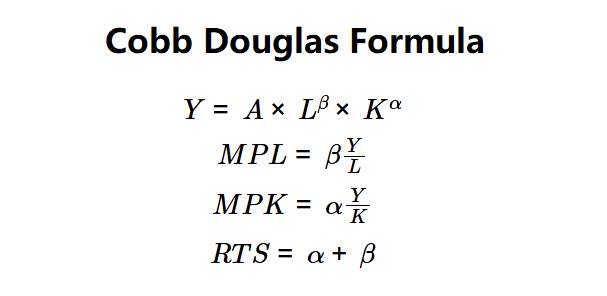1. What is the Cobb-Douglas Production Function Calculator?
Definition: The Cobb-Douglas Production Function Calculator computes the total production of a good based on labor and capital inputs, using the formula \( Y = A \times L^\beta \times K^\alpha \). It also calculates marginal products and returns to scale to analyze production efficiency.
Purpose: Helps businesses and economists understand how labor and capital contribute to output, optimize resource allocation, and assess production scalability.
2. How Does the Calculator Work?
The calculator uses the Cobb-Douglas production function to compute output and related metrics, following these steps and formulas:
Formulas:
\( Y = A \times L^\beta \times K^\alpha \)
\( MPL = \beta \frac{Y}{L} \)
\( MPK = \alpha \frac{Y}{K} \)
\( RTS = \alpha + \beta \)
Where:
- \( Y \): Total production (units)
- \( A \): Total factor productivity
- \( L \): Labor input (units)
- \( K \): Capital input (units)
- \( \beta \): Output elasticity of labor (0 < β ≤ 1)
- \( \alpha \): Output elasticity of capital (0 < α ≤ 1)
- \( MPL \): Marginal product of labor (units per labor)
- \( MPK \): Marginal product of capital (units per capital)
- \( RTS \): Returns to scale (constant if = 1, increasing if > 1, decreasing if < 1)
Steps:
- Step 1: Calculate Total Production (\( Y \)). Multiply total factor productivity by labor and capital raised to their respective elasticities.
- Step 2: Calculate Marginal Product of Labor (\( MPL \)). Multiply \(\beta\) by the ratio of total production to labor.
- Step 3: Calculate Marginal Product of Capital (\( MPK \)). Multiply \(\alpha\) by the ratio of total production to capital.
- Step 4: Calculate Returns to Scale (\( RTS \)). Sum \(\alpha\) and \(\beta\) to determine if returns are constant, increasing, or decreasing.
3. Importance of Cobb-Douglas Production Function Calculation
Calculating the Cobb-Douglas production function is crucial for:
- Economic Analysis: Understands how labor and capital drive output, aiding in productivity studies.
- Business Decisions: Optimizes resource allocation to maximize production efficiency.
- Policy Formulation: Informs policies to enhance economic growth through labor and capital productivity.
4. Using the Calculator
Example (Glass Ball Industry):
\( A = 8 \), \( L = 30 \), \( K = 25 \), \( \beta = 0.4 \), \( \alpha = 0.6 \):
- Step 1: \( Y = 8 \times 30^{0.4} \times 25^{0.6} = 215.13 \).
- Step 2: \( MPL = 0.4 \times \frac{215.13}{30} = 2.87 \).
- Step 3: \( MPK = 0.6 \times \frac{215.13}{25} = 5.16 \).
- Step 4: \( RTS = 0.6 + 0.4 = 1 \) (Constant).
- Results: \( Y = 215.13 \) units, \( MPL = 2.87 \) units per labor, \( MPK = 5.16 \) units per capital, \( RTS = 1 \) (Constant).
Using 30 workers and $25 of capital produces 215.13 glass balls, with constant returns to scale, meaning doubling inputs doubles output.
Example (Scaling Inputs):
\( A = 8 \), \( L = 45 \), \( K = 30 \), \( \beta = 0.4 \), \( \alpha = 0.6 \):
- Step 1: \( Y = 8 \times 45^{0.4} \times 30^{0.6} = 282.26 \).
- Step 2: \( MPL = 0.4 \times \frac{282.26}{45} = 2.51 \).
- Step 3: \( MPK = 0.6 \times \frac{282.26}{30} = 5.64 \).
- Step 4: \( RTS = 0.6 + 0.4 = 1 \) (Constant).
- Results: \( Y = 282.26 \) units, \( MPL = 2.51 \) units per labor, \( MPK = 5.64 \) units per capital, \( RTS = 1 \) (Constant).
Increasing labor to 45 and capital to $30 increases production to 282.26 glass balls, demonstrating constant returns.
5. Frequently Asked Questions (FAQ)
Q: What is the Cobb-Douglas production function?
A: It’s a mathematical model (\( Y = A \times L^\beta \times K^\alpha \)) that describes how labor and capital inputs produce output, with constant or varying returns to scale.
Q: Why are output elasticities important?
A: They measure how responsive output is to changes in labor or capital, guiding resource allocation decisions.
Q: What does constant returns to scale mean?
A: When \(\alpha + \beta = 1\), doubling inputs doubles output, indicating efficient scaling without diminishing or increasing returns.
Cobb-Douglas Production Function Calculator© - All Rights Reserved 2025
 Home
Home
 Back
Back
